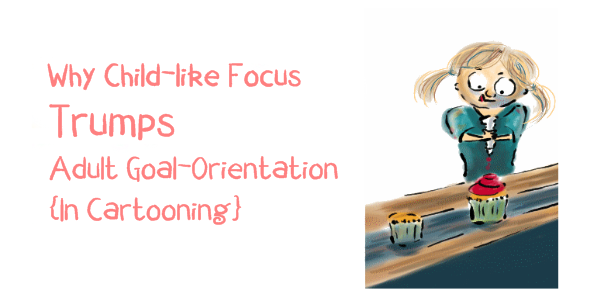Cartooning for adults? Imagine a child let loose to frost a tray full of cupcakes. It’s a messy business, not to mention sticky. And there are all those decorating possibilities to explore. Hey, there’s a colour I didn’t notice. There are twinkly star shapes and… oh my, is that glitter I see…?
It’s basically just an excuse to have fun, and time is definitely not a consideration. In fact, the longer it takes, the better! Now we’re really having fun 😀
Now imagine the same scene but with an adult instead
The frosting gun is locked and loaded and the mental dialogue might go something like this:
“Don’t put too much on”
“That’s too little!”
“Look at all the messy smearing!”
Oh no! Now I’m going to have to wipe that up!”
“Next!”
As adults we want to do things efficiently, which usually means fast. We know we have a certain number of (say) cupcakes to get through, and a limited amount of time.
So we frog march ourselves towards the goal.
There is plenty of goal-setting support for this approach
“Begin with the end in mind,” was a tip from Stephen Covey. And yes, you should keep your goal in mind but with longterm learning, it pays to make sure it’s the right goal.
Take learning cartooning for adults, for example.
When adults start learning to cartoon they tackle their assignments in a workaday fashion. They think the object of the exercise, the goal, is to get it absolutely right, right now.
They feel like all that matters is how it looks. They compare their work constantly to their references. To their classmates. To some imaginary, striven-for standard.
In a nutshell, when cartooning for adults they stress and strain
They fail. And want to give up. Because they are new to this kind of creativity, they are not used to thinking of themselves as competent in this ‘artistic’ world. That makes them extremely self conscious. That adds even more pressure and they naturally want things to look good. When ‘things’ – sketches – don’t work out too well, they take all the lame and berate themselves severely.
What’s the problem?
The thing is, they are focusing on the wrong goal. When you start out in cartooning, you need to focus on putting in the practice, not getting the perfect results.
What they lose sight of is that learning a new skill is a process
If you follow a good process diligently, you make your way towards the desired result. Sometimes you progress in in leaps and bounds, but in real life scenarios it’s more often by inching forwards. In cartooning, as in life, progress is seldom linear. But if you stick to it and trust the process you have selected, progress you will.
You may be thinking “But pottering along doesn’t move me forward”
That depends what you mean by pottering 🙂 Certainly, aimless activity is a waste of time. But if you have a process you trust, your short term goal should be to focus on the process, and trust that the results (the long term goal) will follow.
Keep your long term cartooning for adults goal in mind
And then strike a balance between taking care to do good work vs obsessing over every line.
So for example, your assignment may be to trace, copy and draw.
Keep your reference handy.
‘Measure’ your cartooning results every so often and if things are way out of proportion keep that in mind.
But in general we find that great results are achieved when we focus less. And enjoy more 🙂
A bit like that five year old, icing biscuits.


